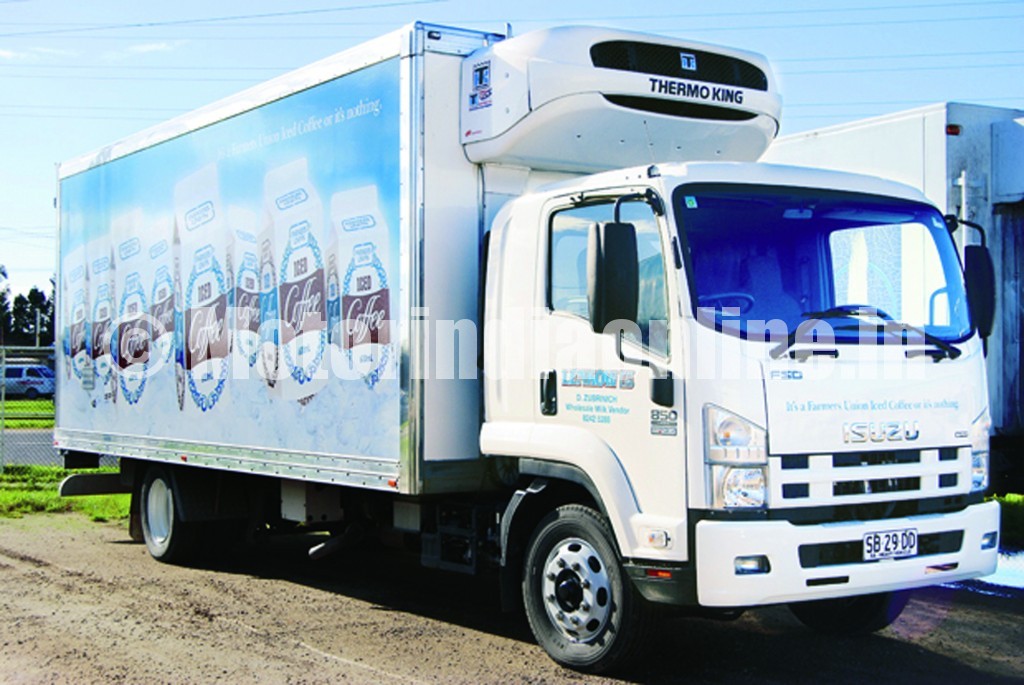Exactly How Refrigerated Trucks Run to Guarantee Safe and Efficient Shipment of Perishable Goods
Refrigerated trucks play an essential function in the supply chain, making certain that subject to spoiling items are moved securely and successfully. Making use of innovative refrigeration technologies and robust insulation, these automobiles keep precise temperature level control, which is important for protecting the high quality of sensitive products.
Overview of Refrigerated Trucks
Chilled trucks, typically described as reefer trucks, play a critical duty in the transport of disposable products across various sectors. These customized cars are developed to preserve certain temperature level varieties, making certain that things such as fresh fruit and vegetables, milk items, meat, and drugs remain secure for usage and effective usage. The procedure of chilled vehicles is crucial in lowering perishing and expanding the life span of temperature-sensitive items.
Reefer trucks are outfitted with protected freight areas that are qualified of sustaining reduced temperatures, which can be readjusted according to the kind of products being transferred. The lorries normally utilize a refrigeration system powered either by the vehicle's engine or an independent source of power, enabling consistent temperature level control during transit.
In addition to temperature level maintenance, these trucks are usually developed with innovative monitoring systems to track the interior setting, guaranteeing conformity with health and security laws. Furthermore, cooled vehicles contribute dramatically to the supply chain, enabling prompt shipments to stores, restaurants, and consumers. Their crucial duty emphasizes the relevance of reliable transport remedies in today's international market, where quality is extremely important.
Trick Refrigeration Technologies
Preserving ideal temperature control in cooled vehicles relies upon a number of essential refrigeration innovations that enhance efficiency and dependability. Among one of the most usual systems is the vapor-compression refrigeration cycle, which uses a refrigerant to absorb heat from the vehicle's inside, reducing the temperature. This process entails a compressor, condenser, expansion shutoff, and evaporator, functioning in tandem to distribute the refrigerant and keep a regular environment.
Another notable modern technology is making use of eutectic plates, which keep and release thermal power. These plates are full of a phase-change material that solidifies at a certain temperature, offering a secure air conditioning source. This approach not only boosts energy efficiency however also reduces the need for continual power supply during transportation.
Additionally, advanced insulation materials, such as polyurethane foam, significantly enhance the thermal performance of chilled vehicles, decreasing temperature level variations throughout discharging and loading. Some modern refrigerated vehicles additionally integrate telematics systems, enabling for real-time tracking of temperature level and efficiency, thus guaranteeing conformity with security requirements. Together, these technologies ensure the secure transportation of disposable goods while optimizing operational efficiency and lessening power intake.
Temperature Control Devices
Effective temperature level control systems are essential in making certain the integrity of subject to spoiling goods during transportation. Chilled trucks utilize innovative modern technologies to preserve consistent temperature level varieties, avoiding wasting and ensuring product safety and security - refrigerated truck companies.
In addition, modern cooled vehicles are outfitted with digital thermometers and programmable temperature tracking systems. These systems permit for real-time tracking of internal temperatures, supplying signals if the temperature deviates from the fixed array. This capacity is vital for conformity with health and wellness guidelines.
Insulation also plays a crucial role in temperature control. Premium insulation products lessen warmth exchange, maintaining the wanted inner problems. In addition, air movement monitoring within the freight location is crafted to make sure consistent temperature distribution, avoiding hotspots that could compromise product honesty (refrigerated truck companies).
Ideal Practices for Filling

This technique permits the temperature level control system to maintain, developing a suitable atmosphere for perishable things. Prevent overwhelming and blocking vents, as this can lead to temperature level fluctuations and hotspots.
Shelving or making use of pallets can assist in arranging products, guaranteeing that larger products are put near the bottom to stop crushing lighter items. Furthermore, it is essential to set apart various sorts of items, specifically those with varying temperature level requirements, to stop cross-contamination and putridity.
Finally, protecting the load with webs or bands will certainly prevent motion throughout transit, therefore decreasing the danger of damages and preserving the honesty of temperature-sensitive items. By sticking to these ideal methods, operators can guarantee reliable and risk-free shipment of perishable goods while making best use of the efficiency of their cooled trucks.
Obstacles and Solutions in Transportation
Transferring products in chilled trucks presents a number of obstacles that can influence the integrity of temperature-sensitive items. One considerable problem is temperature level variations, which can occur due to devices malfunction or incorrect loading techniques. These changes can bring about wasting, compromising the top quality of disposable products. Additionally, roadway conditions and hold-ups can better aggravate temperature level control issues, especially during extended transportation times.
To address these obstacles, applying durable tracking systems is vital. Advanced telemetry can offer real-time temperature level information, notifying motorists to any refrigerated truck companies kind of anomalies. Routine maintenance of refrigeration units makes certain optimum performance and reduces the threat of malfunctions. Moreover, training personnel on best loading and dumping methods can minimize the threat of temperature discrepancies.
One more key option involves path optimization. Utilizing general practitioners and traffic administration modern technologies can assist vehicle drivers choose one of the most efficient courses, reducing transit times and decreasing exposure to negative conditions. Working together with trusted logistics partners who prioritize cool chain integrity is likewise crucial for guaranteeing that items continue to be within needed temperature ranges.

Conclusion
In conclusion, refrigerated trucks play a crucial duty in the efficient and safe transport of disposable products. Using innovative refrigeration technologies and effective temperature control mechanisms guarantees that products continue to be within called for temperature level arrays.
